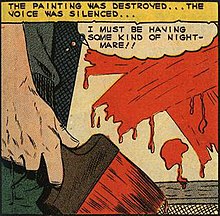Brushstrokes
| Brushstrokes | |
|---|---|
 | |
| Artist | Roy Lichtenstein |
| Year | 1965 |
| Medium | Oil and Magna on canvas |
| Movement | Pop art |
| Dimensions | 122.5 cm × 122.5 cm (48.25 in × 48.25 in) |
| Location | Private collection |
Brushstrokes is a 1965 oil and Magna on canvas pop art painting by Roy Lichtenstein. It is the first element of the Brushstrokes series of artworks that includes several paintings and sculptures. As with all of his Brushstrokes works, it is in part a satirical response to the gestural painting of Abstract Expressionism.
Background[edit]

Prior to producing his first Brushstrokes work, Lichtenstein spun his upcoming work as a "satirical send-up of Abstract Expressionism" by saying: "I'm thinking now of doing something on Abstract Expressionism...The problem there will be to paint a brush stroke, a picture of a brush stroke...Purposely dripped paint and things, you know, where the drips are actually drawn drips that look like drops of water drawn by a commercial artist."[1]
Despite the initial objective of parodying Abstract expressionism, the source for the first Brushstrokes work was a comic strip.[2] Measuring 122.5 cm × 122.5 cm (48.25 in × 48.25 in), Brushstrokes was the first element of the Brushstrokes series.[3] The source for the entire Brushstrokes series was Charlton Comics' Strange Suspense Stories 72 (October 1964) by Dick Giordano.[4][5] According to the Lichtenstein Foundation, in addition to this painting named Brushstrokes, there are also both a sculpture and a screenprint by the same name.[6][7] There is also "Brushstrokes 1970".[8] The Lichtenstein Foundation website also notes that he began creating the Brushstrokes painting in the autumn of 1965 and presented the Brushstroke series at Castelli's gallery from November 20 through December 11.[9]
Detail[edit]
As with many comics-based works, the connection to the source is evident in Brushstrokes. This work depicts a cropped derivation of the source image.[10] In Brushstrokes, as in its source, a hand holds a house painter's paintbrush in the lower left hand corner of the image, while in the upper right a few strokes of paint as well as spatterings of paint are presented. Lichtenstein selected this source because he "...liked the summary rendering of the hand holding the brush and the way in which the cartoonist indicated paint".[2] The three strokes in the upper right are the dominant imagery, while the partial view of the hand in the lower left limited by the edges of the canvas shows paint dripping from the brush.[10] This is an example of Lichtenstein humorously presenting a subject that might be crowded out in a newspaper via a parody that relies on the difference between art and the rest of the world.[11]
See also[edit]
Notes[edit]
- ^ Hatch. p. 57.
When Lichtenstein took up the brushstroke motif in 1965, the gesture was immediately received as a satirical send-up of Abstract Expressionism. The artist himself helped pave the way for this reception. Speaking in a 1964 interview, before he had taken up the theme, he said:...
{{cite book}}: Missing or empty|title=(help) - ^ a b Waldman, Diane (1993). "Brushstrokes, 1965–66". Roy Lichtenstein. Solomon R. Guggenheim Museum. p. 151. ISBN 0-89207-108-7.
Although there is a real connection between the Brushstrokes painting and Abstract Expressionism, the initial source for the series was a panel from the comic strip "The Painting" (fig. 127), in Charlton Comics' Strange Suspense Stories, no. 72 (October 1964). Brushstrokes (fig. 126), 1965, is a direct reprise of that panel. In this painting, a hand holding a brush is situated at the lower-left corner of the canvas while above it to the right are a few bold horizontal and vertical strokes of paint and scattered drips. Lichtenstein liked the summary rendering of the hand holding the brush and the way in which the cartoonist indicated paint. From this image he developed a series of works that explored various aspects of painting,...
- ^ Hatch, Kevin (2007). Pop Art: Contemporary Perspectives. Yale University Press. p. 57. ISBN 978-0-300-12212-1.
- ^ Foster, Hal (2010). Francis, Mark (ed.). Pop. Phaidon. p. 150. ISBN 978-0-7148-5663-6.
Begun in the autumn of 1965, Lichtenstein's series of Brushstroke paintings was initiated after he saw a cartoon in Charlton Comics' Strange Suspense Stories. 72 (October 1964). One scene shows an exhausted yet relieved artist who has just completed a painting. This depicts two massive brushstrokes that take up the entire surface area. The absurdity of using a small paintbrush to create an image of two monumental brushstrokes was explored in many different variations. Transforming an expressive act that was mythologized for its immediacy and primal origins into a cartoon-like, mechanically produced-looking image, Lichtenstein created a reflexive commentary on gestural painting.
- ^ "Strange Suspense Stories #72". Lichtenstein Foundation. Retrieved May 25, 2012.
- ^ "Brushstrokes". Lichtenstein Foundation. Retrieved May 28, 2012.
- ^ "Brushstrokes". Lichtenstein Foundation. Retrieved May 28, 2012.
- ^ "Brushstrokes, 1970". The Lichtenstein Foundation. Archived from the original on March 15, 2011. Retrieved July 4, 2012.
- ^ "Chronology". Roy Lichtenstein Foundation. Archived from the original on May 7, 2012. Retrieved May 9, 2012.
- ^ a b Rondeau, James and Sheena Wagstaff (2012). Rigas, Maia M. (ed.). Roy Lichtenstein: A Retrospective. Art Institute of Chicago. p. 50. ISBN 978-0-300-17971-2.
- ^ Rondeau, James and Sheena Wagstaff (2012). Rigas, Maia M. (ed.). Roy Lichtenstein: A Retrospective. Art Institute of Chicago. p. 75. ISBN 978-0-300-17971-2.
